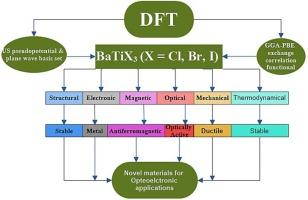Comprehensive DFT analysis of novel transition metal-based BaTiX3 (X = Cl, Br, I) halide perovskites: Structural, electronic, magnetic, optical, mechanical, and thermodynamic properties
IF 3.9
3区 材料科学
Q2 MATERIALS SCIENCE, MULTIDISCIPLINARY
Materials Science and Engineering B-advanced Functional Solid-state Materials
Pub Date : 2024-11-12
DOI:10.1016/j.mseb.2024.117788
引用次数: 0
Abstract
The Ti-based BaTiX3 (X = Cl, Br, I) halide perovskites are investigated using DFT with the GGA-PBE functional to explore their optical, magnetic, electronic, mechanical, and thermodynamic properties. The electronic band structure and density of states reveal a metallic nature for all compounds, while phonon calculations confirm the thermal stability of BaTiI3, with no negative lattice vibrational frequencies. Negative formation energies of −4.34, −3.87, and −3.40 eV/atom indicate thermochemical stability. Spin-polarized band structures show non-magnetic behavior. Mechanical stability is verified by Born stability criteria, and anisotropic, ductile behavior is confirmed using the anisotropic factor and Poisson’s ratio. Thermodynamic properties, including enthalpy, entropy, free energy, and heat capacity, are calculated, with zero-point energies of 0.11 eV, 0.07 eV, and 0.18 eV for BaTiX3. Optical properties reveal all materials are active in the lower energy region. These results provide a comprehensive understanding of BaTiX3 perovskites for advanced applications.

新型过渡金属基 BaTiX3(X = Cl、Br、I)卤化物包晶的综合 DFT 分析:结构、电子、磁性、光学、机械和热力学特性
本研究采用 GGA-PBE 函数的 DFT 方法研究了钛基 BaTiX3(X = Cl、Br、I)卤化物包晶,探讨了它们的光学、磁学、电子学、力学和热力学性质。电子能带结构和态密度揭示了所有化合物的金属性质,而声子计算则证实了 BaTiI3 的热稳定性,其晶格振动频率不为负。负形成能分别为 -4.34、-3.87 和 -3.40eV/原子,表明了热化学稳定性。自旋极化带结构显示了非磁性行为。机械稳定性通过博恩稳定性标准得到验证,各向异性和韧性行为则通过各向异性因子和泊松比得到证实。计算得出的热力学性质包括焓、熵、自由能和热容量,BaTiX3 的零点能分别为 0.11 eV、0.07 eV 和 0.18 eV。光学特性显示,所有材料在低能量区都很活跃。这些结果使人们对用于先进应用的 BaTiX3 包晶石有了全面的了解。
本文章由计算机程序翻译,如有差异,请以英文原文为准。
求助全文
约1分钟内获得全文
求助全文
来源期刊
CiteScore
5.60
自引率
2.80%
发文量
481
审稿时长
3.5 months
期刊介绍:
The journal provides an international medium for the publication of theoretical and experimental studies and reviews related to the electronic, electrochemical, ionic, magnetic, optical, and biosensing properties of solid state materials in bulk, thin film and particulate forms. Papers dealing with synthesis, processing, characterization, structure, physical properties and computational aspects of nano-crystalline, crystalline, amorphous and glassy forms of ceramics, semiconductors, layered insertion compounds, low-dimensional compounds and systems, fast-ion conductors, polymers and dielectrics are viewed as suitable for publication. Articles focused on nano-structured aspects of these advanced solid-state materials will also be considered suitable.

 求助内容:
求助内容: 应助结果提醒方式:
应助结果提醒方式:


